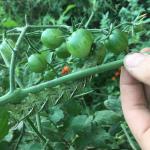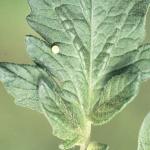Hornworm, Tomato
Manduea quinquemaculata
Late July and early August are usually the time when we see tomato hornworms. These large caterpillars typically appear in small numbers and cause their impressive feeding damage to just a few leaves or plants. Larvae consume large amounts of foliage on peppers, tomatoes, eggplant, potatoes, and related solanaceous weeds.
Identification:
There are two species of hornworm that feed on tomatos - tobacco hornworm (Manduca sexta) and tomato hornworm (Manduca quinquemaculata). The spherical greenish-yellow eggs of both species are deposited singly on the undersides of host plant leaves. The eggs hatch in approximately one week and larvae begin feeding on foliage.The larvae of both species feed for 3-4 weeks, molt five times, and may reach 4 inches in length and 1/2 inch in width when fully ground. Larvae are green with a distinct "horn" on the top of the tail end. The horn of the tobacco hornworm is red, while the horn of the tomato hornworm is dark blue or black. Larvae of both species have a series of white stripes along their sides; tobacco hornworms have black margins along the white stripes, while tomato hornworms have green margins along the white stripes.
Full-grown larvae burrow 3-4 inches into the soil and form dark brown, two-inch long pupae. A sheath for the mouthparts projects from the head of the pupa and curves downward, resembling the handle of a pitcher.
Life Cycle:
There is one generation per year in northern areas. The adults are large moths, predominately gray or gray-brown with lighter markings. They are commonly referred to as sphinx, hawk, or hummingbird moths. The adult tomato hornworm is known as the five-spotted hawk moth while the adult tobacco hornworm is called the Carolina sphinx. The wingspread may reach five inches and the hairy, robust abdomen has yellow spots. They emerge from over wintered pupae in the soil in late spring or early summer. The moths are commonly seen at dusk, hovering hummingbird-like over beds of petunias and other flowers with long corollas. Nectar is extracted through their long, coiled, tube-like mouthparts.
Monitoring & Thresholds:
Scout by searching leaves for damage, frass or larvae. Often one sees defoliated stalks or the characteristic dark-green droppings (fecal pellets) before the caterpillar is located.
There is no set economic threshold for this pest in tomato. Where damage is unacceptable, or if there are high numbers, foliar sprays can be used.
Biological Controls:
A parasitic Braconid wasp is an important and fairly common natural enemy of the hornworms. The wasps lay their eggs inside the body of the caterpillars. After feeding within the caterpillar body, the larvae of the wasps eat out through the skin and spin the cocoons on the caterpillar surface. The adult wasps later cut out circular lids and escape from the cocoons to attack other hornworms. If one is hand-picking hornworms, those with cocoons of parasitic wasps on their back should not be killed.
Chemical Controls & Pesticides:
Use a selective material that will conserve beneficial insects, because those predators and parasites are very likely keeping your aphid populations under control. Insecticides include Bacillus thuringiensis (Bt) kurstaki or aizawi strain (Dipel DF, Agree, or Xentari, etc.), indoxycarb (Avaunt), tebufenozide (Confirm 2F), or spinosad (SpinTor 2SC or Entrust). Several synthetic pyrethroids are also labeled (note: these could result in aphid outbreaks). Although Bt usually works best on small larvae, in this case it will work very well even against large hornworms. In peppers, any controls used for European corn borer should control hornworms.
For Current information on production methods (including varieties, spacing, seeding, and fertility), weed, disease, and insect management, please visit the New England Vegetable Management Guide website.
Crops that are affected by this insect:
The Center for Agriculture, Food and the Environment and UMass Extension are equal opportunity providers and employers, United States Department of Agriculture cooperating. Contact your local Extension office for information on disability accommodations. Contact the State Center Director’s Office if you have concerns related to discrimination, 413-545-4800 or see ag.umass.edu/civil-rights-information.


